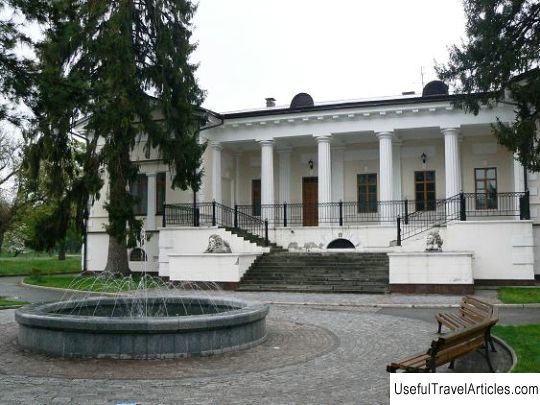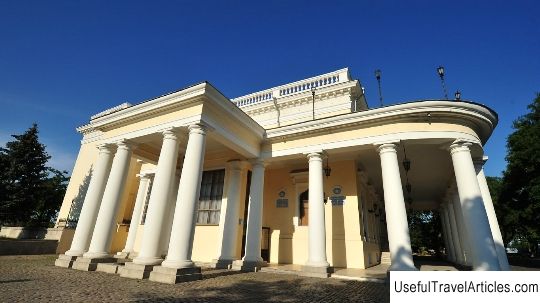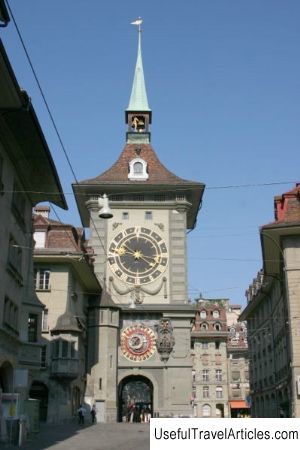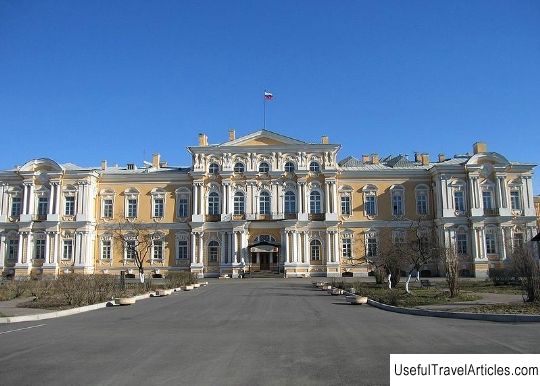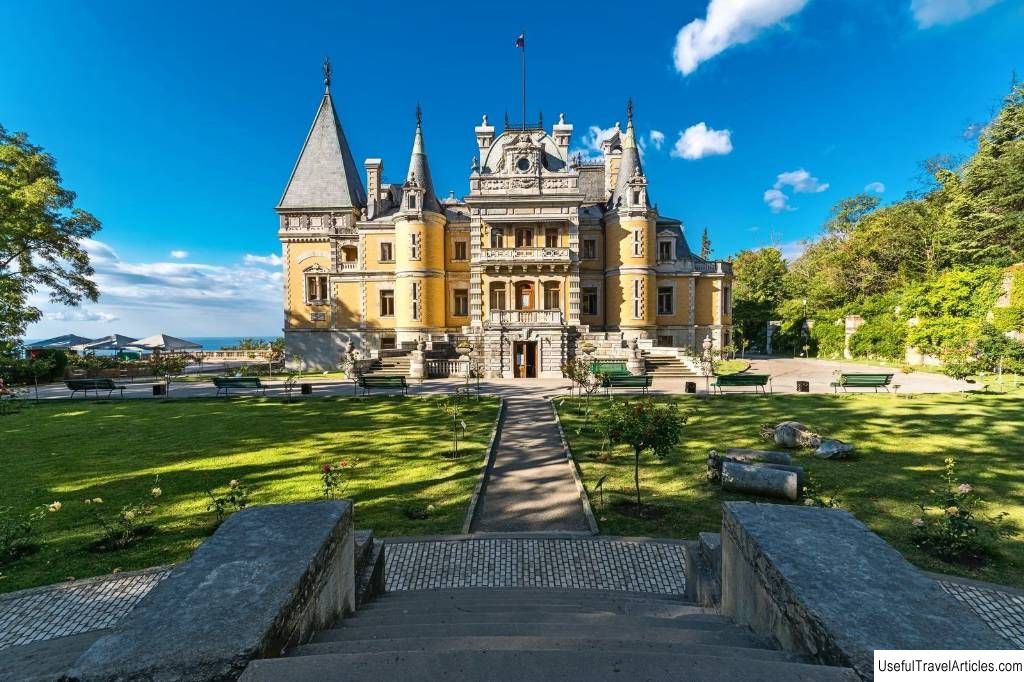Vorontsov Palace and Park description and photos - Crimea: Alupka
Rating: 7,5/10 (100 votes) 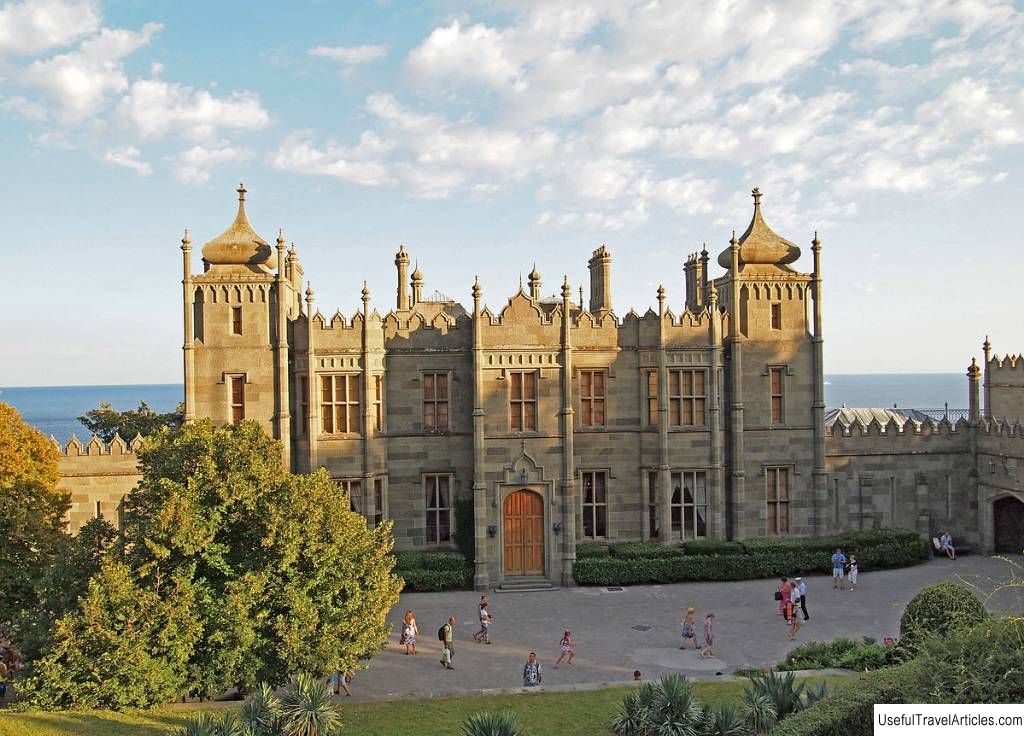
Vorontsov Palace and Park description and photo - Crimea: Alupka. Detailed information about the attraction. Description, photos and a map showing the nearest significant objects. Photo and descriptionThe main attraction of Alupka is the palace of the Governor-General of the Novorossiysk Territory, Count Mikhail Vorontsov . It was built in 1828-1848 at the foot of the mountain Ai-Petri and is now a museum. Mikhail Semenovich Vorontsov (1782-1856), the son of the famous Englishman and Russian envoy to London Semyon Vorontsov, was the most famous Russian nobleman. He was well educated, handsome and brave. He went through the Turkish wars, the war of 1812 and foreign campaigns, participated in the capture of Paris, and then commanded the occupation forces in France. His portrait by D. Dow hangs in the famous military gallery of the Hermitage. In 1823 he was appointed governor-general of Novorossiya - and since then his life has forever been connected with the south of the Russian Empire. MS Vorontsov still fought: in 1828 he took Varna, in the 40s he turned out to be the Caucasian commander-in-chief, but his main business was the development of Novorossiya. His main residence was Odessa (now the city is decorated with a monument to Vorontsov), and here he was buried. In Odessa and Chisinau, he met with Pushkin , who was in exile in these places. They say that Pushkin had an affair with Vorontsov's young wife and he was jealous. Most likely, there was no romance, but the poet was distinguished by a rather cheeky behavior in society and could compromise her. Therefore, his relationship with Vorontsov was extremely strained. There are several poignant Pushkin epigrams left in history, dedicated to this. Building a palace Relax Vorontsov came to Crimea. He decided to arrange a summer residence for himself in Alupka: these were fantastically beautiful, but almost deserted places, apart from a very small village. Vorontsov loved everything English since childhood . He entrusted the construction of the palace to the Englishman Thomas Harrison . He was an honored elderly architect, an old acquaintance of his father: he designed buildings in Lancaster Castle, many bridges in England and even prison castles. But Harrison only managed to create a rough draft and passed away. Then Vorontsov entrusted the construction to another Englishman, younger - Edward Blore . He collaborated a lot with the British royal house. It was he who completed and decorated the famous Buckingham Palace. And now Blore conceived a grandiose palace, in which all styles from English Gothic to Moorish would be mixed, and so that the whole would look surprisingly harmonious. He included part of the project of the previous master in his own - for example, the niche of the main portal. The construction itself was supervised by the third Englishman - William Gunt . Work on the palace and park lasted from 1828 to 1848. It was built conscientiously, from the most durable Crimean stone - diabase (the correct modern name for this breed is dolerite). In total, there are five buildings and more than a hundred luxuriously decorated rooms. They began to build from the canteen building, and the central one was urgently completed by 1837, when they came to Crimea Nicholas I with the heir. By this time, the house was ready enough to receive the emperor. The last to appear was the lion terrace , decorated with six sculptures of lions - each with its own character. The lower lions are sleeping, the middle ones are playing, and the upper ones are guarding the entrance and carefully watching the sea. Of course, such a huge farm required a huge number of workers, and then - servants. They all lived here too, so the complex was a whole city. The palace was built by Vorontsov's serfs , but they were paid for it and it was very good for those times: from ten to twenty rubles a month (other noblemen received smaller amounts from their estates). Part of it went to pay the rent (after all, serfs), but a lot remained on hand. Upper and Lower Parks In addition to the palace itself, there is a separate huge the park created by the genius gardener Karl Antonovich Kebach . Kebach was a hereditary gardener from a German family: the Kebachs in Germany have been engaged in gardens since the 17th century. He devoted half his life to this park: from 1824 to 1851 he was engaged practically exclusively in it. He wrote off and communicated with botanical gardens, was close friends with the second director of the Nikitsky Botanical Garden N. Gartvis . It was here that Kebakh got married. A separate Gothic-style house was built for his family. At the end of his life, he was considered the main specialist in southern Crimea - without his advice, no gardens were planted in any estates. Vorontsov Park occupies almost forty hectares and rises from the sea like an amphitheater. The upper landscape park is arranged in a romantic style and diligently copies the wildlife, however, every detail is carefully thought out. Here again the owner's enthusiasm for everything English has affected - this type of park was invented by the British. In the Upper Park, you should pay attention to the following attractions: - Big and Small chaos . These are two large groups of dolerite lying volcanic boulders as if in disorder - the European version of the "rock garden". In fact, their location is calculated, and inside there are paths and streams, ornamental species of shrubs are specially planted - for example, strawberry, which looks beautiful against the background of gray-green stones. - Moonstone - a twenty-meter rock on the outskirts of Lesser Chaos. One of its edges is so flat that it can reflect moonlight. - Swan, Moon and Mirror Ponds . They are also surrounded by boulders and stylized as mountain lakes. Several bags of semi-precious stones were once poured into the bottom of Swan Lake so that they shimmer beautifully under the sun. Swans have been living here since Vorontsov's times. Once upon a time roses were planted along the banks. The lunar lake was specially made to admire it in the moonlight: the bottom is strewn with silvery sand. Mirror lake is the smallest and most secluded one. The trees around it are specially planted at an angle to reflect beautifully in the water. - The park's glades . Plane meadow, on which, in addition to plane trees, also grows exotic Chilean araucaria, which is more than 130 years old. Peacocks fly to the branches of plane trees Sunny glade - a view of Ai-Petri opens from here and a cypress tree, which is more than 200 years old, grows here. A contrasting meadow - trees and shrubs have been specially selected here, sharply differing from each other in the color of leaves and trunks. The lower, ceremonial park is more regulated , it descends with terraces to and from the sea magnificent views of the sea, the front facade of the palace and the staircase with lions open up. A hundred-meter palm alley, planted with roses descends to the sea. Here it is worth seeing fountains . The fountain of tears, inspired by Pushkin's poem "The Fountain of Bakhchisarai", the fountain of cupids, the fountain "shell", source "cat's eye". The park is decorated with Polovtsian "stone women" - statues that in the X-XI centuries. Polovtsians put on their mounds. Soviet period The Vorontsovs owned this place before the revolution. The last was the granddaughter of Mikhail Semenovich - Elizaveta Dashkova , close to the last empress. She did a lot of charity work: for example, during the First World War, hospitals were opened in all of her mansions, both here and in St. Petersburg. But the revolution forced her to emigrate, and the palace went to the Soviet government. The palace was lucky - it was not plundered and ruined, but became a museum , where nationalized values were brought from all over the peninsula ... The building was almost a hundred years old, but it turned out to be so strong that it was not damaged during the earthquake of 1927 . Even during the occupation, the museum managed to preserve the buildings and most of its collections (although the director of the museum after the war sat down for aiding the invaders). During the Yalta conference an English delegation was settled here: Winston Churchill lived in the former chambers of Vorontsov himself. For some time after the war, the palace was used as a summer residence, then as a sanatorium , but in 1956 a museum was reopened here. Palace-Museum This is the richest Crimean museum, there are more than 11 thousand exhibits . In the post-war years, it was often used for filming . "Mio, my Mio", "Heavenly Swallows", "Ordinary Miracle", "Amphibian Man" - this is not the whole list of films that were filmed in this place. Now the museum has five permanent exhibitions and several successive exhibitions. First of all, people come here, of course, to look at the ceremonial halls of the Main Building , decorated in the English style. The interior decoration is almost completely preserved here. In the one-storey guest wing there is a section dedicated to the daughter of Mikhail Vorontsov - S. M. Shuvalova. Here you can see the collections of paintings and prints that this family collected, and the interiors of the late 1840s. The utility building is dedicated to the work of the kitchen: huge cast iron stove, dishes, cookbooks, pantries - everything that had to do with providing the hosts with tasty and healthy food. A separate exposition tells about the life of Vorontsov's butlers and the problems of managing this entire huge economy. Interesting facts : - Moscow Red Square is paved with the same Crimean stone, from which the palace was built. - There is a legend among the museum staff that during the years of occupation Hitler secretly came here. - In Alupka, they often tell the following joke: Winston Churchill, walking with Stalin in the park, offered to sell England one of the sculptures of lions. Stalin said that he would not sell, but if Churchill answered his riddle, he would donate. The riddle sounded like this: "Which finger is the most important on your hand?" "Pointing", - Churchill answered, and he was wrong - Stalin showed him a fig in response.          We also recommend reading Cold War Museum description and photos - Russia - Moscow: Moscow Topic: Vorontsov Palace and Park description and photos - Crimea: Alupka. |
